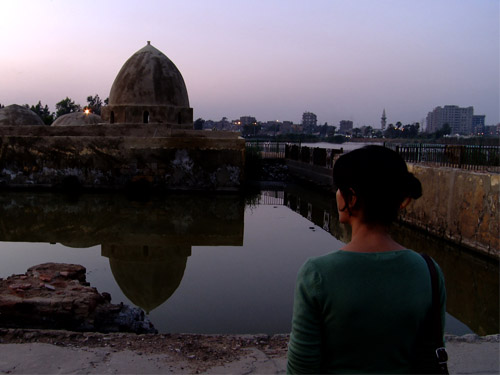
At some point during the shooting of “Ein Shams” in 2008, Ibrahim El Batout had a camera rigged on a moving car. Without a shooting permit, he was recording tracking shots of Cairo’s streets, to be used as a backdrop for the film credits. As the car crossed Qasr al-Nil Bridge, the camera came face to face with a police checkpoint, framing three policemen vigilantly waving for the car/camera to pull over; as it does, the frame glides slowly to a stop in front of a blinking yellow street sign. This shot — an example of the spontaneous rewards filmmakers might get from adopting such a guerrilla approach — struck Batout as the perfect closing shot he could have never planned for.
Four years later, the closing scene of “Winter of Discontent” shares the same location. The key difference is that this time, Batout has a permit to halt the flow of traffic, and the budget to have a full film crew execute complicated flying crane movements, achieving high-end shots of actors and actresses taking protesting poses over the bridge.
Tempting as it may be, comparing the artistic merit of these two scenes is futile. But they still work well as landmarks to visualize the linear progression of the independent cinema scene in Egypt from 2008 to 2012, in terms of production modules and cinematic language.
Another important marker in this timeline is the work of Hala Lotfy, whose debut feature film “Coming Forth By Day” premiered at the 2012 Abu Dhabi Film Festival, winning the Best Director from the Arab World and the FIPRESCI awards.
Back in 2008, Lotfy and Batout, along with fellow filmmaker Tamer El Said, decided that uniting forces was the only way they could stand up to the commercial cinema industry. Their idea of collaboration developed into the low-budget project unofficially titled “Backdoor to a Morning,” a self-produced feature film composed of nine segments, with each director writing and directing three of them. But the members of the new front found they agreed more on what they rejected than on an alternative. The film project sunk soon after Lotfy finished shooting one of her segments, signaling the beginning of different routes toward achieving “independence” in cinema.
In the last four years, two paths have been forged in the attempt to take filmmaking away from the deeply established entity that is mainstream Egyptian cinema. The reform-minded path focused on presenting alternatives to address certain flaws in the existing system: new actors versus movie stars, documentary style versus artificial studios, and improvisation versus meticulous scripts. But this path did not have core issues with mainstream cinema, allowing some filmmakers to make use of established distribution channels and production facilities. Interestingly, this proximity allowed the mainstream to benefit from the freshness of this new scene growing in parallel to it, whether through attracting talents grown in the indie field, or even imitating the low-budget filmmaking model in a period of economic crisis.
The more radical method decided that the conflict with mainstream cinema was about core principles and cut all ties with the existing system. It put its energy into imagining and realizing a new system of production and distribution. Considering every aspect of the cinema establishment to be virulent, proponents of this method insist that establishing a real alternative is worth the effort spent, even if the production process is slower and more difficult.
Filmmakers from both camps, however, share the same predicament when it comes to financing film projects. They are faced with the natural skepticism toward anything new and the callous attitude of television channels and other popular outlets toward alternative culture. While independent filmmakers can do much to reduce their budgets, filmmaking is ultimately a costly practice that cannot practically depend on personal funds or crowd-sourcing schemes.
Since Shady Abdel Salam failed in the 1970s in his decade-long project to produce the epic film “Akhenaton” exclusively with sovereign Egyptian money, filmmakers working outside of the commercial field have mostly relied on foreign funding.
Yet concerns over capital’s influence on artwork persist; everyone has an agenda, and this challenges the basis of the “independent” cinema movement. In this regard, it is relevant to stop again at Lotfy’s “Coming Forth by Day.”
Lotfy’s approach was self-reflective from the start. She identified her strengths and weaknesses, and exercised a meditative process to explore her identity as a filmmaker. This was evident in the film’s cinematic style as well as in her production structure. With most of the scenes occurring indoors, and most of these indoor scenes shot in one apartment, Lotfy constructed a safe incubator for her first film. And by renting that apartment on a monthly intead of a daily basis, she minimized the negative impacts in quality that usually come with tight shooting schedules.
The same apartment now hosts the headquarters for her newly-founded production house, Hassala.
2012 thus marked a breakthrough for the Egyptian alternative cinema movement. Lotfy raised the bar for local art house cinema, and Batout took steps, whether deliberate or not, toward creating wider public appeal. Alongside those trends was a surge in the production of short films that confirms the steady influx of creativity and talent integral to this independent cinema movement.
The certain result is that the dynamic range within the alternative scene is expanding; the two unorthodox production approaches are materializing beyond the untested nature of theories. For filmmakers and audience, the choices are not just present, but they are now clearer than ever.




